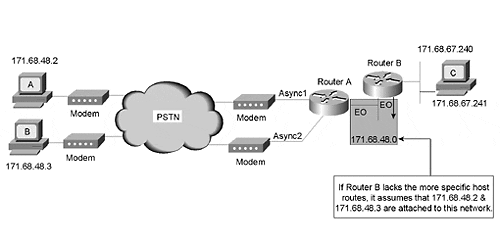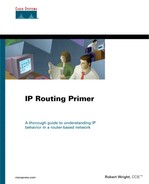Understanding IP Unnumbered
One of the reasons IP unnumbered is possible is that with only two hosts on any serial link—when the routers are at either end—there is no confusion about which device a packet is originating from or destined for. The following are a few rules that apply to using IP unnumbered:
The serial interface must be a point-to-point link.
You must use the same major network with the same mask on both sides of the WAN link.
or
You must use different major nets with no subnetting on both sides of the WAN link.
These rules are discussed in more detail in the following sections.
IP Unnumbered Causes Host Routes and Lost Connectivity
This section provides some background on IP unnumbered and some real-life scenarios of IP unnumbered in action. Figure 4-1 represents the network topology used for most of this section.
Figure 4.1. Simplified network using IP unnumbered.

In Table 4.1, the routing update from RouterC has a bit (1) set in the fourth octet (.1 = 00000001). RouterA compares this update with the mask of the IP address and the mask used by the unnumbered ethernet0 command. RouterA will discover that a bit is set outside the range of the mask, which must be interpreted as a host route.
| Advertised mask | 168.71.8.1 = 10101000.01000111.00001000.00000001 |
| Router's mask | 255.255.255.0 = 11111111.11111111.11111111.00000000 |
See the section on mask ambiguity in Chapter 3, "Discontiguous Networks, Summarization, and Subnet 0," for more information on this issue.
Host Routes
As previously explained, a host route refers to a route whose associated mask has all 32 bits set to 1—255.255.255.255. For an address and mask such as this, there can be only one host.
One common cause of host routes is a route advertisement that has bits set in the range that the receiving router interprets as outside of the subnet mask. In this case, the router compared the advertisement received from an adjacent router with the mask of the interface it was received over and found a mismatch. This is how RIP V1 and IGRP determine the mask to apply to advertisements they receive.
Table 4.1 shows an example of an advertisement that has a bit set to 1 in a region of the address not covered by the subnet mask in use.
Another common cause of host routes is a routing update explicitly advertised with a mask of 255.255.255.255. Routing protocols such as OSPF and EIGRP include the masks associated with the routes in their routing updates.
Host routes are also often manually configured to resolve routing problems related to configuring dial-on-demand routing (DDR). The following section on DDR goes into more detail on this subject.
Hosts Routes Using DDR
Dial-up users may require host routes to ensure that they have full connectivity to the network. Although dial-up networking is beyond the scope of this book, this section attempts to clarify when host routes can be useful. In the scenario in Figure 4-2, hosts A and B use modems to dial into the corporate network.
Figure 4.2. Async dial-up network using IP unnumbered without host routes.

In Figure 4-2, RouterA is using IP unnumbered ethernet 0 on its Async interfaces. This results in multiple Async interfaces sharing the same subnet as a local Ethernet. However, the router needs to be able to keep track of the interfaces as separate subnets in order to route traffic correctly.
Remember that one of the rules of IP unnumbered is that it must be used only for point-to-point network connections. Extending the mask already applied to RouterA's Ethernet 0 interface when the addresses are configured on the asynchronous interfaces provides this point-to-point connection. Interface Async1 has an address of 168.71.48.2 255.255.255.255, and interface Async2 has an address of 168.71.48.3 255.255.255.255.
When all of the hosts are connected to RouterA (they have dialed in to the network), they will have their own unique routes (their host routes) in RouterA's routing table. If RouterA receives a packet for 168.71.48.4 from HostA, it does a longest match lookup of its routing table and determines that the best match is the subnet applied to its Ethernet 0 interface: 168.71.48.0. It forwards the packet out of that interface.
On the other hand, if RouterA receives a packet for 168.71.48.2 from HostB, the longest match lookup results in a match for the host route applied to Asynch1: 168.71.48.2. The packet is forwarded out that interface to HostA (assuming either that the link to HostA is already up or that RouterA is configured to place a call to HostA when it receives a packet for it).
Without host routes being advertised by RouterA to RouterB for end systems A and B, RouterB assumes that an IP packet to 171.68.48.2 or 171.68.48.3 is for an end system on the Ethernet network connecting RouterA and RouterB. The gray box surrounding the (E0) interfaces for routers A and B in Figure 4-2 shows where RouterB assumes that addresses 171.68.48.2 and 171.68.48.3 reside. RouterB ARPs (attempts to determine the layer two MAC address) for 171.68.48.2 or 171.68.48.3 directly instead of forwarding the packet to RouterA to reach end system A.
Note
If you do not understand the role of the Address Resolution Protocol (ARP), refer to Chapter 7, "Bridging IP Between Dissimilar Media," or RFC 826.
In Figure 4-3, RouterA is advertising the host routes for end systems A and B. RouterB will do a longest match lookup for packets to either 171.68.48.2 or 171.68.48.3 and discover that the connected route to 171.68.48.0 is not the longest match. RouterB will determine that these routes are reachable via its Ethernet 0 address, using RouterA as the next hop.
Figure 4.3. Async dial-up network using IP unnumbered without host routes.

The gray box surrounding HostA and HostB in Figure 4-3 shows where RouterB will assume that addresses 171.68.48.2 and 171.68.48.3 reside now that the correct host routes are being advertised by RouterA.
This section has given you an intentionally simplistic example of DDR. DDR is an incredibly complex subject that can take up an entire book all by itself. Consult the documentation for the version of Cisco IOS you are using for more information on DDR internetworking. The next section explains how to configure IP unnumbered in non-DDR situations.
